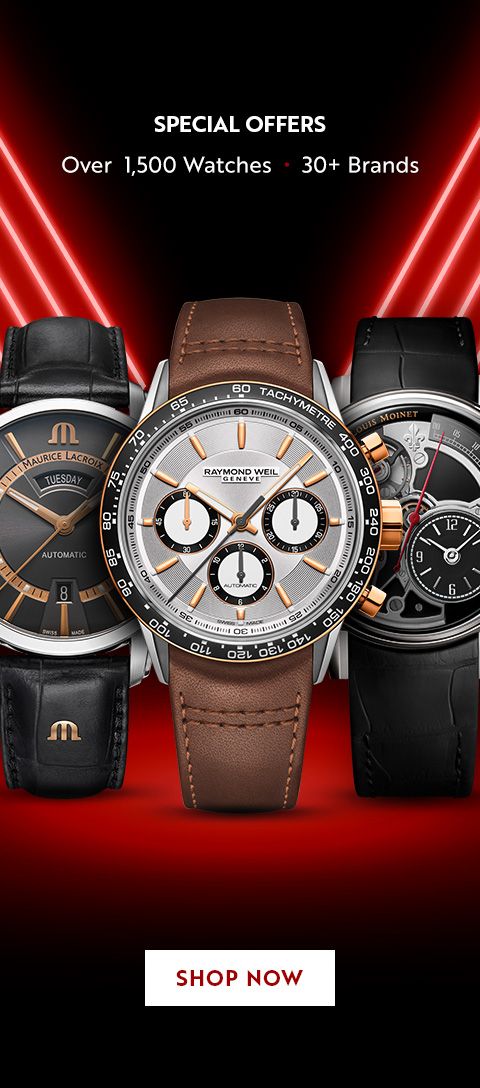Trending Articles from The Watch Guide

Let It Glow, Let It Glow, Let It Glow: The Glowing Case Of The BR X5 Green Lum By Bell & Ross

Lasered Kaleidoscope: Presenting The Oris ProPilot X Calibre 400 Laser

Set In Stone: Introducing The Jacob & Co Palatial Classic Collection’s Stone Dials

Retro, Winning Charm: Raymond Weil's Millesime—A Tribute To Understated Elegance
Junghans - Creating Time
A brand that has its genesis going all the way back to 1861—known then as Junghans and Tobler—Junghans began by producing clocks in the Lauterbachtal valley in Schramberg, Germany. By 1903, Junghans watches had over 3,000 employees meticulously working towards producing timepieces, and they manufactured over three million of them per year, making them the largest watch and clock factory in the world!
In 1918, Junghans watches was responsible for the creation of an icon in watchmaking—their nine-stepped terraced factory in the Black Forest valley of Schramberg. Designed by Stuttgart industrial architect Philipp Jakob Manz, it was built so that the watchmakers tinkering around inside would be able to make optimal use of the daytime sun. This inevitably made Junghans’ watches incredibly precise and efficient. The Terrassenbau building went on to become a watchmaking and tourism landmark, catapulting the Schramberg area to fame. To honour the centenary of this achievement, the brand released the Meister Chronoscope Terrassenbau Limited Edition watches in 2018. These watches depict this building on the case back and are limited to 100 pieces for the rose gold variant and 1,000 pieces for the stainless steel variant.
The In-House Innovations
By 1936, Junghans was fitting its watches with its own in-house movements, making the brand self-sufficient and self-reliant. The J80 calibre was one of the first movements produced by the brand. The J80/2 was the next iteration of the same movement, and this came with the Côtes de Genève decoration. This became the calibre that powers Junghans’ famous Meister collection, which wins widespread acclaim and praise to this day.
In the year 1949, Junghans created its first hand-wound chronograph with the in-house J88 movement. It became the first pilot watch for the newly formed Bundeswehr (unified German military) and, soon after, was released for civilian use.
By 1951, Junghans was the largest producer of chronometers in Germany and by 1956, it had secured its position as the third-largest in the world—growing from strength to strength along the way.
The max bill Era
From the 1950s to the 60s, Junghans watches went through a pivotal time in their history. This is when the brand enlisted the help of Swiss architect, painter and designer Max Bill—one of the most influential designers of the 20th century. Having studied at the Bauhaus school in Dessau, he first designed a kitchen clock, and then went on to collaborate with Junghans to make minimalistic wristwatches that break design norms and keep the Bauhaus legacy alive. In fact, such is Junghans’ connection with the Bauhaus school that, in 2019, Junghans watches launched the max bill 100 Years Bauhaus to commemorate 100 years of the Bauhaus school of art. In fact, the building of the school, with its iconic red door, is depicted on the case back of this timepiece.
In the 1970s, when the quartz crisis was ravaging the Swiss watch industry, the brand produced its own quartz watch to stay ahead of the curve—the Astro-Quartz.
In 1972, Junghans achieved another milestone—it became the official timekeeper of the Olympic Games, held in Munich that year. This ensured that the entire world became familiar with the brand and recognised its offering’s precision and accuracy when it came to timekeeping.
The Culmination Of Radio-Controlled Solar Powered Watches
In 1990, the brand attained even greater heights all thanks to the invention of the radio-controlled wristwatch, which functioned on the environment-friendly solar power.
Junghans has had a deep connection with the automotive industry ever since Arthur Junghans—son of the founder, Erhard Junghans—took the reins of the company. Arthur was a great friend of Gottlieb Daimler and Wilhelm Maybach, the men who paved the way for the modern automobile industry. In 2017, the brand released the Meister Driver, solidifying Junghans’ relationship with automobiles. The Meister Driver is a wonderful homage to classic cars and automotive racing.
It is evident through the brand’s many horological offerings that Junghans watches has always managed to stay one step ahead of the curve at every moment of its history, and it continues to embody this same fervour and spirit of excellence even today. As of today, Junghans has several recognisable collections, such as 1972, Radio Control & Solar, Mega, Meister, FORM, and max bill, which find favour with avid horologists all around the world. One such collection worth mentioning is the Mega series, a radio-controlled timepiece. The accuracy of the radio-controlled Mega series is such that the movement corrects the second hand movement every minute—also called “intelligent time correction”.
With a strong desire to forge a connection with the general public and increase awareness about Junghans’ amazing legacy, the watchmaker inaugurated the company museum to mark the 150th anniversary of the watch factory in 2011.
The Junghans brand has won hearts with its inventive design philosophies, creative craftsmanship and avant-garde technology. Bearing the signature eight-point star, each Junghans timepiece is a horological representation of pure passion, superlative quality, unmatched style and abounding energy, and certainly deserves to be on your wrist.


